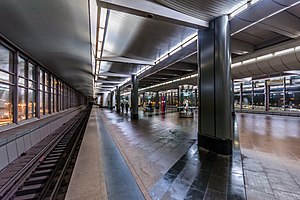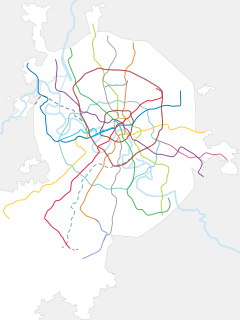You can help expand this article with text translated from the corresponding article in Russian. (September 2012) Click for important translation instructions.
|
| This article needs additional citations for verification. Please help improve this article by adding citations to reliable sources. Unsourced material may be challenged and removed. Find sources: "Vorobyovy Gory" Moscow Metro – news · newspapers · books · scholar · JSTOR (December 2012) (Learn how and when to remove this message) |
Vorobyovy Gory (Russian: Воробьёвы го́ры, lit. Sparrow Hills) is a Moscow Metro station. It is on the Sokolnicheskaya Line, between Universitet and Sportivnaya stations. Its name originates from a nearby elevated area literally translated as Sparrow Hills.
History

The bridge, which is known as the Luzhniki Metro Bridge, or simply "Metromost", and spans the Moskva River, was originally built in 1958. The architects for the project were M. P. Bubnov, A. S. Markelov, M. F. Markovsky, A. K. Ryzhkov, and B. I. Tkhor. The bridge, hastily built, was plagued by corrosion and seeping water and fell into disrepair. It was deemed structurally unsound by 1984, so the station (at the time called Leninskiye Gory) was "temporarily" closed for repairs and trains were rerouted to temporary bridges alongside. Eighteen years later on December 14, 2002, the newly renovated station was opened to the public once again. As the historic name of Sparrow Hills (Vorobiovy Gory) (renamed Lenin Hills in 1935) was restored in 1999, the station was named in honor of the landmark.
Design
Built into the lower level of a bridge, it is unique in the city. At 282 metres (925 ft) in length, the platform is the longest in the system as the station needed to be accessible from both sides of the river. It is also the highest station above ground level at 15 metres (50 ft), though this is less remarkable since all but a handful of Metro stations are underground. Apart from its dimensions, Vorobyovy Gory is also notable in being the only Moscow Metro station with windows.
References
- "Метрополитен в цифрах" (in Russian). Moscow Metro. Retrieved 2018-03-17.
External links
 Media related to Vorobyovy Gory at Wikimedia Commons
Media related to Vorobyovy Gory at Wikimedia Commons
| Moscow Metro | |||||
|---|---|---|---|---|---|
| |||||
| |||||
| |||||
| |||||
| |||||
| |||||
| Kalininsko-Solntsevskaya line | |||||
| |||||
| |||||
| |||||
| |||||

